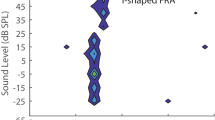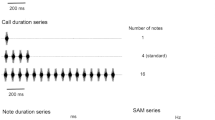Summary
-
1.
The excitatory response properties of 130 single units in the torus semicircularis of the northern leopard frog (Rana p, pipiens) were recorded. 86% responded maximally to single tones. 14% responded maximally only to specific combinations of 2 or more tones, and were either completely unresponsive or weakly responsive (<20% maximal response) to single tones over a wide range of intensities.
-
2.
Single tone responders were placed in 6 classes on the basis of configurations of their excitatory tuning curves. Neurons in each class also tended to show similar inhibitory response properties, particularly in regard to exhibiting partial or total two-tone inhibition (TTI). Neurons with symmetrical excitatory tuning curves generally exhibited only partial TTI, while those with more asymmetrical curves exhibited total TTI.
-
3.
Inhibitory response properties were determined for 78 single tone responders. 69% could be totally inhibited by a second tone; the remainder showed only partial two-tone inhibition (TTI). Most neurons exhibiting total TTI (74%) had best inhibitory frequencies (BIFs) which were lower than the best excitatory frequencies (BEFs). Only 26% had BIFs > BEFs.
-
4.
Absolute thresholds for total TTI by frequencies lower than the BEF were sometimes independent of the intensity of the excitatory tone. The property was not observed in the absolute thresholds for total TTI by higher frequencies, in which case all inhibitory thresholds were elevated upon increasing the intensity of the excitatory tone.
-
5.
A small number of neurons were either unresponsive or weakly responsive (<20% maximal excitation) to broad-band stimulation. This response property was associated with total TTI in which the relative inhibitory threshold was lower than the intensity of the excitatory tone.
-
6.
Neurons requiring 2 or more tones for maximal excitation all had restricted excitatory frequency bands from which the tone combinations could be drawn. These neurons were placed in two categories: those requiring narrowly separated (<200 Hz) tones and which had a single excitatory frequency band, and those which required more widely separated (>500 Hz) tones and had two excitatory bands. The latter category required the presence of one tone from each band to be excited.
-
7.
All multiple tone responders could be totally inhibited by the addition of a single tone to the excitatory tone combination. Also, all multiple tone responders had non-monotonic intensity-rate functions, with excitatory intensity ranges as narrow as 25 dB and as broad as 50 dB.
-
8.
The frequency selectivities of all multiple tone responders matched the spectral features of the species mating call. Their possible role in the selective detection of this call is discussed.
Similar content being viewed by others
Abbreviations
- BEF :
-
best excitatory frequency
- BEI :
-
best excitatory intensity
- BIF :
-
best inhibitory frequency
- DMN :
-
dorsal medullary nucleus
- MTR :
-
multiple tone response
- STR :
-
single tone responder
- TS :
-
torus semicircularis
- TTI :
-
two-tone inhibition
References
Blair WF (1963) Acoustic behavior of amphibia. In: Busnel RG (ed) Acoustic behavior of animals. Elsevier, New York, pp 694–708
Bogert CM (1960) The influence of sound on the behavior of amphibians and reptiles. In: Layon WE, Tavolga WN (eds) Animal sounds and communication. Am Inst Biol Sci, Washington, DC, pp 137–320
Capranica RR (1966) Vocal response of the bullfrog to natural and synthetic mating calls. J Acoust Soc Am 40:1131–1139
Capranica RR (1976) Morphology and physiology of the auditory system. In: Llinás R, Precht W (eds) Frog neurobiology. Springer, Berlin Heidelberg New York, pp 551–575
Capranica RR, Moffat AJM (1974) Evidence for mechanical origin of peripheral inhibition in the anuran inner ear. J Acoust Soc Am 55 (Suppl) 85
Capranica RR, Moffat AJM (1980) Nonlinear properties of the peripheral auditory system of anurans. In: Popper AN, Fay RR (eds) Comparative studies of hearing in vertebrates. Springer, Berlin Heidelberg New York, pp 139–165
Comer C, Grobstein P (1981) Organization of sensory inputs to the midbrain of the frog,Rana pipiens. J Comp Physiol 142:161–169
Feng AS (1975) Sound localization in anurans: An electrophysiological and behavioral study. Thesis, PhD Degree, Cornell University, Ithaca, New Jersey
Feng AS, Capranica RR (1978) Sound localization in anurans. II. Binaural interactions in superior olivary nucleus of the green treefrog (Hyla cinerea). J Neurophysiol 41:43–54
Feng AS, Shofner WP (1981) Peripheral basis of sound localization in anurans. Acoustic properties of the frog's ear. Hear Res 201–216
Frishkopf LS, Capranica RR (1966) Auditory responses in the medulla of the bullfrog: Comparison with eighth nerve response. J Acoust Soc Am 40:1262–63
Frishkopf LS, Goldstein MH (1963) Responses to acoustic stimuli from single units in the eighth nerve of the bullfrog. J Acoust Soc Am 35:1219–1228
Frishkopf LS, Capranica RR, Goldstein MH (1968) Neural coding in the bullfrog's auditory system — a teleological approach. Proc IEEE 56:969–980
Fuzessery ZM, Feng AS (1981) Frequency representation in the dorsal medullary nucleus of the leopard frog,Rana p. pipiens. J Comp Physiol 143:339–347
Gerhardt HC (1974) The significance of some spectral features in mating call recognition in the green treefrog (Hyla cinered). J Exp Biol 61:229–241
Harnischfeger G (1979) An improved method for extracellular marking of electrode tip positions in nervous tissue. J Neurosci Methods 1:195–200
Kruse KC (1981) Phonotactic responses of female northern leopard frogs (Rana pipiens) toRana blairi, a presumed hybrid, and conspecific calls. J Herpetol 15:145–151
Liff H (1969) Responses from single auditory units in the eighth nerve of the leopard frog. J Acoust Soc Am 45:512–513
Liff H, Goldstein MH (1970) Peripheral inhibition in auditory nerve fibers in the frog. J Acoust Soc Am 47:1538–1547
Loftus-Hills JJ (1971) Neural correlates of acoustic behavior in the Australian bullfrogLimnodynastes dorsalis (Anura: Lepto-dactylidae). Z Vergl Physiol 74:140–152
Mecham JS (1971) Vocalization of the leopard frog,Rana pipiens. and three related Mexican species. Copeia 3:505–515
Mudry KM, Capranica RR (1980) Evoked auditory activity within the telencephalon of the bullfrog (Rana catesbeiana). Brain Res 182:303–311
Mudry KM Constantine-Paton M, Capranica RR (1977) Auditory sensitivity of the diencephalon of the leopard frog,Rana p. pipiens. J Comp Physiol 114:1–13
Narins PM, Capranica RR (1980) Neural adaptations for processing the two-note call of the Puerto Rican Treefrog,Eleuthero-dactylus coqui. Brain Behav Evol 17:48–66
Potter HD (1965a) Patterns of acoustically evoked discharges of neurons in the mesencephalon of the bullfrog. J Neurophysiol 28:1155–1184
Potter HD (1965b) Mesencephalic auditory region of the bullfrog. J Neurophysiol 28:1132–1154
Scheich H, Langer G, Bonke D (1979) Responsiveness of units in the auditory neostriatum of the guinea fowl (Numida meleagris) to species-specific calls and synthetic stimuli. J Comp Physiol 132:247–276
Walkowiak W (1980) The coding of auditory signals in the torus semicircularis of the fire-bellied toad and the grass frog: Responses to simple stimuli and to conspecific calls. J Comp Physiol 138:141–148
Young ED, Brownell WE (1976) Responses to tones and noise of single cells in dorsal cochlear nucleus of unanesthetized cats. J Neurophysiol 39:282–300
Zakon H, Capranica RR (1981) Reformation of organized connections in the auditory system after regeneration of the eighth nerve. Science 213:242–244
Author information
Authors and Affiliations
Rights and permissions
About this article
Cite this article
Fuzessery, Z.M., Feng, A.S. Frequency selectivity in the anuran auditory midbrain: Single unit responses to single and multiple tone stimulation. J. Comp. Physiol. 146, 471–484 (1982). https://doi.org/10.1007/BF00609443
Accepted:
Issue Date:
DOI: https://doi.org/10.1007/BF00609443




